Your feedback is important to us
Please provide any feedback you have. Thank you!
Thank you!
Your feedback has been submitted.
- Partnership for Assessment of Readiness for College and Careers
Please provide any feedback you have. Thank you!
Your feedback has been submitted.

See what skills are tested, understand your child's scores, and get ideas for how you can help at home.
When reading and analyzing fiction, seventh graders look closely at how a story’s setting, plot, and characters affect each other. For example, in The Adventures of Tom Sawyer, the rural river region where the story takes place (the setting) lends itself to Tom and his friends exploring an island, a cave, and a haunted house (the plot). Students need to cite evidence when they describe these connections.
Seventh graders should also be able to analyze how the structure of a poem or play adds to its meaning. For example, in the poem The Road Not Taken by Robert Frost, a student should recognize that the first stanza sets up the narrator’s dilemma (which road to take) and the next stanza tells the reader what the narrator chose to do (which road he/she took).
Watch how a teacher gets middle schoolers to talk about what they’re reading.

When comparing a written version of a story to a film, stage performance or multimedia version, seventh graders should be able to analyze how the techniques of each medium influence the experience of the story. For example, a student could note that the suspenseful soundtrack in the movie Little Women helps express the girls’ worry about their father.
Get expert info — After seeing the latest movie, find a discussion about it online, in a magazine, or in your community. Listening to experts talk about a topic in depth will challenge your child’s critical thinking. This can make for excellent dinner table conversation. For example, the movie based on the novel The Martian has triggered a lot of discussion about the relevance of math and science knowledge.
Read historical fiction — Help prepare your child to compare fiction and nonfiction texts about historical events by finding historical fiction books for her to read. For example, The Diary of Anne Frank is a wonderful window into learning about World War II. Find out what history-related topics your child is studying in school and ask your school or city librarian for recommendations. After reading a chapter, ask your child to summarize what she read, citing evidence from the text. Ask your child to describe how events presented in the text compare to what she has read in history texts or historical documents.
When you talk to your child’s teacher, ask what your child needs to work on when reading fiction. Does she struggle to cite evidence when she summarizes? Can she tell you what different characters think about the same events? If she needs help with these skills, ask the teacher for a list of questions you can ask your child to help her build these skills.
Seventh graders’ thinking is becoming more sophisticated. They should now be able to read and summarize material like Martin Luther King’s “I Have a Dream” speech, without inserting their own opinions.
To do this, students should use the author’s language as evidence for their summary. For example, a student might write, “We know Martin Luther King wanted to emphasize the enduring pain created by slavery by referring to the slaves who had been seared in the flames of withering injustice.”
Seventh graders should also compare how two writers present information and look closely at which facts are emphasized by each. For example, in social studies they might compare a diary of an unemployed worker during the Great Depression to an opinion piece by a politician from that time claiming that the economy is improving.
Watch how middle schoolers do research on a topic.

Seventh graders must learn to analyze how and why a science or social studies text is organized in a particular way and how that may affect a reader’s understanding of the information.
What’s the difference? — There are lots of science and history documentaries out there. Watch two documentaries on a science or history topic your child is studying and compare them. Do they focus on the same key ideas? Or does one emphasize certain information more than the other? Have a conversation about why this might be.
Read graphics — Find an article that includes graphs, tables, or diagrams. Choose one you think will intrigue your child — a story about a crazy weather pattern or a trend story about video games or sports or chocolate consumption! Read the article and analyze the graphics together. What do the graphics add to the main idea of the text? (Newsela.com has wonderful articles and you can choose your child’s reading level.)
Ask your child’s teacher about his strengths and weaknesses in nonfiction reading. Ask what you can do at home to help him understand history or science texts.
As students move through middle school, they come across more figurative language in their reading. They need to know that the phrases You can’t teach an old dog new tricks and It’s a dog-eat-dog world are not referring to four-legged canines. Students also study the effect of rhyme and alliteration (words that start with the same sounds). They also learn to use synonyms (words with similar meanings) and antonyms (opposite meetings). They also need to use context to figure out words with multiple meanings. Take the sentence I managed to bluff my way out of doing my chores by pretending I had a stomach ache. If a student is unsure whether the word bluff means cliff or lie, she should replace the word in the sentence with a synonym to help her decide which sounds correct in context.
Seventh graders also learn about how a word’s connotation (emotional association) gives the reader a clue into the writer’s point of view. In an article about homelessness, for example, the author reveals his empathy for the situation of homeless people by using the word unable: The homeless in America are simply unable to find jobs due to a lack of opportunity.
It’s important for seventh graders to build their academic vocabulary. These words are broadly used in many subjects and even in everyday conversation, but kids sometimes have trouble understanding their meaning. The words acquire, devastate, initiate, and omit are examples of academic vocabulary. The best way for your child to learn new words is through conversation and reading. Print out this list of academic vocabulary words that your seventh grader should know and try to use one word in conversation every day. This will help with your child’s reading, speaking, and writing this year — and the future! These are the same words your child needs to know for the SAT and ACT tests. Sign up for GreatWords, our free vocabulary-boosting text message program, to get daily text messages with 7th grade academic vocabulary words. To get started, text WORDS to 88769. (See terms and conditions.)
When you talk to your child’s teacher, ask what your child’s strengths and weaknesses are. Ask for specific examples of what your child is having trouble with. Is she making connections between multiple readings? Does she understand how to formulate a strong argument? Then ask the teacher for questions you can ask your child at home or activities that you can do as a family to help build these skills.
By seventh grade, students should be skilled at organizing their writing. They should introduce their topic or opinion clearly, use evidence and logical arguments to explain their ideas, and choose words and phrases — like regardless and for this reason — to lead readers smoothly through the piece.
As seventh graders develop their arguments or topic, they should use academic terms appropriate to the content and include definitions of the terms they use — for example: segregation, the practice of separating groups of people. They should also include graphics — like tables and charts — to help the reader better understand an idea.
In previous grades, students were asked only to develop their own argument or opinion. But in seventh grade they’re asked to recognize and describe an opposing opinion. For example, when trying to persuade a reader that exercise is fun, a student might write Some people think exercise is hard, painful, and boring, but it can be more enjoyable than watching TV. For now they are not expected to argue against an opposing opinion, they simply need to note its existence.
Watch middle schoolers develop an informational essay.

In narrative writing, students should organize the story’s events logically. To help the story flow they should use dialogue, description, and transition words and phrases that signal shifts in the story. For example, words like meanwhile and suddenly tell the reader they’re about to learn something new.
Writing gives kids the opportunity to play with words and ideas creatively. Encourage your child to try out words she’s learned and use silly descriptions when writing and telling stories.
Daily free write — Ask your child to explore what’s on his mind. Set a timer to three minutes and have him write without stopping until the time runs out. Even if he starts writing I don’t know, I don’t know, I don’t know, that’s okay. Your child can write about anything and doesn’t need to show anyone (even you!). If free writes are particularly challenging, provide your child with a “sentence starter” to help him (for example, The funniest thing happened on the way home from…).
Personal POV — It’s entirely normal for young teens to be focused on themselves and their thoughts. Channel this energy by asking your child to write about a personal experience from his point of view (POV), like an argument with a sibling or why he loves or hates a certain sports team.
Talk it out — Before your child puts pencil to the page (or fingers to keyboard) for an assignment, encourage her to talk about what she’s going to write. Talking helps writers organize their thoughts and makes the actual writing easier.
Read more! — That’s right; there’s a huge link between reading a lot and writing well. When your child reads things he likes, he absorbs new words and interesting turns of phrase that he can use in his own writing.
Story hour — The structure and details involved in telling a good story about your day have a lot in common with the energy and specificity you want in your child’s writing. So even if you can’t get your child to sit down with pen in hand, telling stories from your day with a focus on using vivid details and clear logical sequencing will help your child hone her language and thinking skills.
Schedule a meeting with your child’s teacher to find out her strengths and areas that need improvement in writing. Make sure to ask for specific tips for how to help her improve her writing skills.
Seventh graders should be able to use multi-clause sentences to create relationships between ideas. For instance, with the simple sentences She was exhausted and She slept badly all night, your child should be able to connect them to create a compound sentence: She was exhausted and she slept badly all night or a complex sentence: She was exhausted because she slept badly all night. .
Seventh graders should also create lots of details in their writing to make it more interesting and readable. When they do, they should remember to separate two adjectives that describe the same noun (coordinate adjectives) with a comma. For example, It’s going to be a long, hot day.
Seventh graders should also be able to revise their own work to make sure it is clear. By eliminating wordiness, students can make sure their writing gets straight to the point. For example, the following wordy sentence can be revised to express the same idea more clearly:
Wordy: He worked a few jobs during the summer because he knew he should help support his family by working.
Concise: He worked all summer to support his family.
Seventh graders should also be able to recognize and correct dangling modifiers. For instance, in the sentence Having arrived at the store, there was no chocolate ice cream, kids should be able to see that the person who arrived at the store is not the subject of the sentence. The student should be able to revise with something like: Having arrived at the store, the girl discovered that there was no chocolate ice cream.
By now students should be spelling most words correctly. This includes general words (irrelevant and perceive) and subject-specific words (constellation and sedimentary).
Cut it out — Give your child a wordy sentence to revise. Ask her to tell you the most important information and to rewrite the sentence with as few words as possible, while still maintaining its main idea. You can even play this as verbal game with simpler sentences.
Gotcha! — Tell your child you’re going to make grammatical mistakes in your speech during the day and give him a dime for every mistake he catches you making. Before you start the day, give a few examples so that your child knows what to look out for.
Meet with your child’s teacher to find out if she needs help with grammar, punctuation, or spelling. What activities can you do at home to help your child improve these skills?
Rational numbers: Using number lines and the four operations (+, –, x, ÷) to work with rational numbers — which include positive and negative numbers, decimals, and fractions — and solve real-world problems.
Algebra: Solving algebraic equations (such as 35 = –2.5 – 3.5x) and inequalities (such as 10 – x > 11 – x) with at least one variable (unknown number).
Proportional relationships: Analyzing and representing proportional relationships (e.g., $3.50 per pound) in tables, charts, graphs, diagrams, and equations to solve real-world, multi-step word problems involving ratios and percents.

Let’s set aside the fact that the words middle schoolers and rational aren’t usually found in the same sentence. Why? Because this year, students learn the fundamentals of rational numbers, which include any positive or negative whole number or decimal that can be expressed as a simple fraction. Here’s where it gets a little complicated — no, make that exciting: a decimal that can be expressed as a fraction (including repeating decimals such as .333, which is 1⁄3 in fraction form) is rational, but a decimal that goes on forever with non-repeating numbers and can’t be expressed as a fraction, such as the square root of 2 or the mighty pi, π, is known as irrational. More on that in eighth grade; in seventh, the focus is on rational numbers.
Kids need to be really good at using the four operations (+, –, x, ÷) with rational numbers in all forms — positive and negative numbers, fractions, and decimals. Students should be comfortable placing these numbers on a number line and using number lines and the four operations to solve real-world problems. In solving real-world problems, students are expected to fluidly convert numbers from decimals to fractions (and vice versa). For example, to find Adriana’s 10% raise on $25 an hour, students should be comfortable multiplying by 0.1 (the decimal) or 1⁄10 (the fraction).
Watch how seventh graders add and subtract rational numbers.

Seventh grade math teachers do some heavy lifting. They prepare students for high school algebra by teaching new rules, procedures, and properties to use when solving equations with negative numbers and variables. For example:
A ratio is a way of comparing numbers, units, or quantities, such as running one mile in 6 minutes, 2 miles in 12 minutes, etc. This is known as a proportional relationship. Seventh graders learn to use both fractions and decimals in these relationships. They learn to test whether these relationships are really proportional by modeling them with a chart, number line, table, or graph. If a relationship is proportional, kids should be able to create an equation that represents the relationship.
Here’s an example of a proportional relationship represented by a table and an equation. Let’s say a runner can run 1 mile in 10 minutes. Students may create this table and write the equation y = 10x to explain this relationship. (In y = 10x, x is the number of miles run, and y is the total number of minutes.)
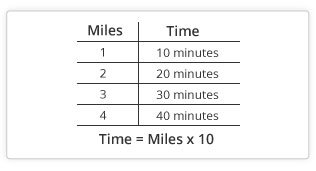
In addition to writing and solving equations with variables (e.g., 2x + 4 = 12), seventh graders work with inequalities using greater than (>), greater than or equal to (≥), less than (<), and less than or equal to (≤). For example, say a salesperson is paid $50 per week plus $3 per sale, and this week he wants to earn at least $100. With x representing the number of sales, an inequality showing this might be $50 + $3x ≥ 100.
Sample problem 1: Adding and subtracting rational numbers
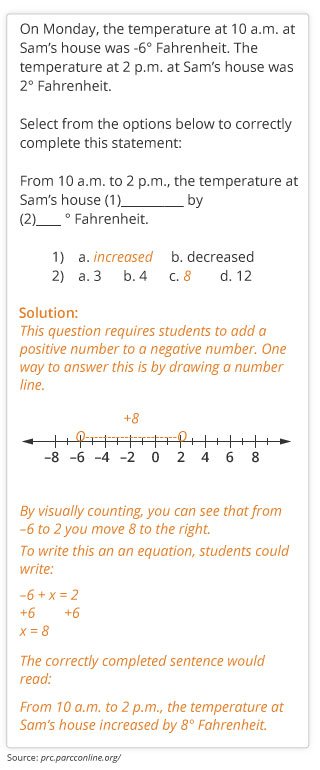
Sample problem 2: Multiplying rational numbers

Sample problem 3: Recognizing and representing proportional relationships
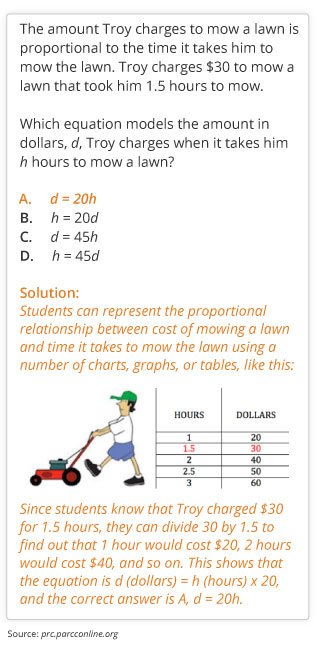
Sample problem 4: Using tables, graphs, and equations to work with proportional relationships/ratios

Sample problem 5: Using the distributive property to simplify equations

Sample problem 6: Solving inequalities

Seventh graders encounter a lot of negative numbers, but remember to keep everyone’s attitude toward math positive. Research shows that your good attitude toward math will improve your child’s attitude — and his performance in math.
In middle school, it can be tough to schedule time to talk to all of your child’s teachers, but it’s worth it! The best way to start a conversation with your seventh grader’s math teacher is to ask questions such as What are the most important things my child should learn in your class this year? and What are typically the toughest concepts? What should I be on the lookout for in my child’s homework to make sure he’s getting it? Be ready to take notes on what the teacher says. When you talk about specifics, it’s easier to ask for resources, tips, and ideas on ways you can help your child.

Not everything your child learns in seventh grade math is given equal weight under the standards or the PARCC test. Think of Additional and Supporting Content like the chorus line in musical theater. They may not have the solos, but remove their dance numbers and the show will fall flat. And, while the skills in this section aren’t Major Content this year, these skills either support (or extend) the major concepts this year — or they’re the building blocks for concepts that’ll be major concepts in a year or two.
Take, for example, this question about probability: A seventh grade class did a survey. They asked a random sample of 80 students at their middle school what their favorite sport was. If 17 students chose bowling, and there are 865 students at the middle school, what’s the most reasonable estimate of the number of students whose favorite sport is bowling?
(a) 43 (b) 147 (c) 182 (d) 765
To answer this question, students need to use probability, and apply it to what they know about ratios. As a percent, 17 out of 80 is about 21%. And 21% of 865 is about 182.
Remember teaching your child how to ride a bike? After he fell for the twentieth time, skinned his knee, dropped the bike, and whined, I’ll never be able to do this, you didn’t say, Yeah, I could never do it, either. You said, Keep trying, I promise you’ll get it. And he did. Make that your math mantra, too. Never let him give up. There is no special math gene. With patience and support, everyone can be great at math. It’s just like riding a bike.
Seventh grade is an important year in math. If your child is falling behind or just not grasping something, ask the teacher when your child started having problems. You want to pinpoint the problem(s). Then get suggestions for online math games, worksheets, or other activities your child can do outside of school to make sure she catches up.

We teach our children not to be defensive, but math is all about defending your work — in a logical, clear, and reasoned way. Students are expected to understand the logic of math, which means knowing the rules for the order of operations. Kids need to be ready to defend their reasoning on any given problem. To do so, they must explain the processes they use to solve problems and support their answers using equations, diagrams, and other visuals.
Seventh graders are also required to use mathematical reasoning to critique their classmates’ work and explain why they think a solution is right or wrong. Students may be asked to compare two answers to the same word problem, identify the correct one, and support their decision using mathematical reasoning — including using mental math — to estimate whether an answer even makes sense based on what they know about procedures and rules.
Sample problem 1: Developing a clear argument to explain and defend solutions
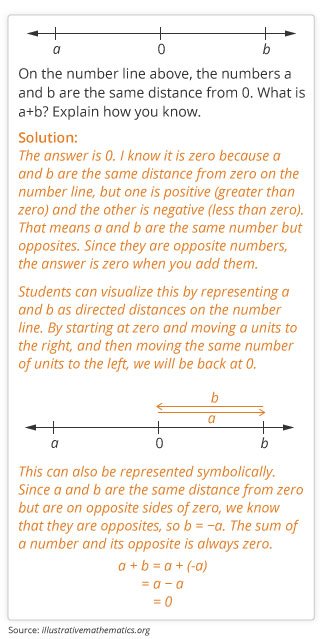
See how seventh graders explain the relationship between positive and negative numbers.

Sample problem 2: Critiquing the reasoning of others
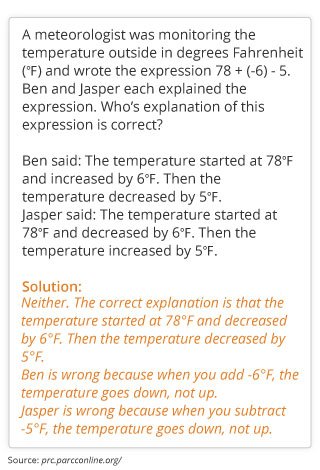
Seventh graders should use their understanding of proportional relationships, their ability to simplify equations, and their mental math skills to determine if an answer is reasonable. For example, they should know without having to calculate on paper that if a 2-pound bag of apples costs $10, it wouldn’t make sense for a 5-pound bag to cost $7, unless the store is giving a major discount for buying in bulk.
Sample problem 3: Using mental math and estimation to determine whether an answer makes sense
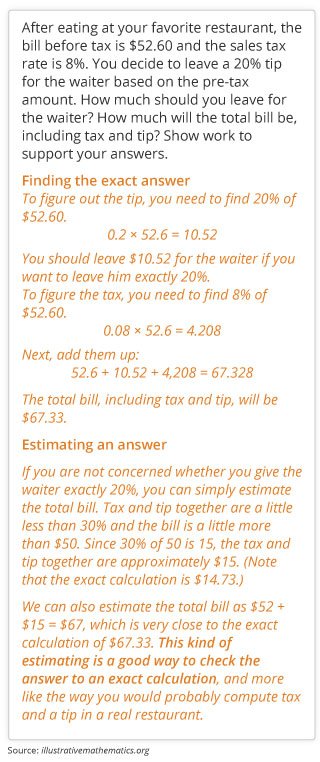
Have fun with math! Cultivating a positive attitude toward math really is half the battle when it comes to your children excelling in math class.
Teachers have amazing information and resources. Schedule a meeting to discuss your child’s math work. Ask the teacher to explain where your child is struggling using examples from his classwork, homework, or tests. Get some specific tips on how to help at home, including any websites or games that combine fun with learning.

Modeling and application means taking real-world numerical relationships and using math to represent them. Modeling is a process students use to understand and solve problems. At this age, kids might use graphs, tables, charts, pictures, number lines, or algebraic expressions or equations to make sense of a problem as they formulate, compute, interpret, validate, and report their answer.
Many modeling problems ask your child to read a chart or plotted points and create an equation or expression and use it to solve the problem.
Seventh graders are expected to know how to illustrate and represent relationships between quantities in several ways, including using tables, charts, graphs, and equations.
Sample problem 1: Identifying models and equations that show the same relationship

Watch how these seventh graders solve a multi-step word problem.

The sample problem below is a multi-step ratio problem that can be approached in many ways.
Sample problem 2: Solving real-life situations using a variety of strategies

Want to know the most important — and easiest — way to help your child? It’s having a positive attitude about math. Research shows that a parent’s attitude toward math is contagious; so just by having a good attitude, you are helping your child with math. So yes, you are a math whiz — and your child will be one, too.
Is your child good at problem solving? Ask the teacher! Your child’s math teacher has a whole new perspective to share with you about your child’s math skills. Ask to see a range of sample problems that seventh graders should be able to solve — from easy ones to brain-teasing stumpers. Can you solve them yourself? Ask the teacher to explain each one, and then take them home and try them with your child. Your interest + tackling problems together = a much more motivated math student.

GreatKids created this guide to help you understand your child's state test scores and to support your child's learning all year long. We worked with PARCC and leading teachers in every grade to break down what your child needs to know and exactly how you can help